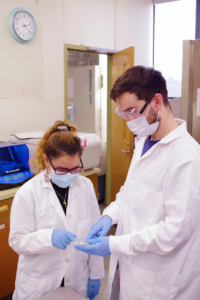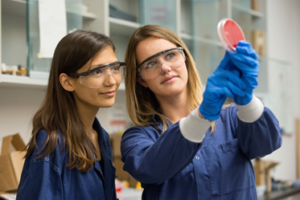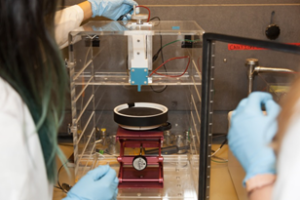Contact Information
Professor
Biochemistry
Email: kencornell@boisestate.edu
Office: MATH 225B
Phone: (208) 426-5429
Research Interests
- Enzymology / Antibiotic & antiparasitic drug development
- Medical devices to treat chronic wounds
- Novel materials with antimicrobial activity
- Animal and tissue culture models of infectious disease and cancer
Educational Background and Research
Undergraduate Research Assistant
What am I looking for in an undergraduate research assistant?
What courses would you recommend for students to have taken prior to working in your laboratory?
Ideally, students working in my lab will have finished general chemistry and maybe taken a microbiology lab course. However, I take students at all levels, from freshman onward. Students should be interested in infectious disease, medical devices & coatings, and antibiotic development.
How many hours per week do you expect a student to spend in the laboratory per research credit and does the time have to be a set schedule?
I generally expect a minimum of 6 hours per week per research credit. Largely this is because students will not learn a sufficient amount of techniques or gain enough hands-on practice to have a positive impact on experiments in the lab without spending at least 6 hours per week in the lab. The time is not on a set schedule, per se, but is adaptable to the student’s class schedule. New students will not work in the lab during evening and weekend hours until they have sufficient experience to be independent and safe (generally not their first semester).
Ideally, for what length of time would a student research in your laboratory to achieve a meaningful research experience?
I do not take students who are only interested in a one semester experience. The minimum is usually a year, and I prefer students to try and join the lab 2 years (or more) before they graduate. The added time is paid off in improved summer internships, publications, conferences, and more meaningful letters of recommendation for employment and applications for professional schools.
Educational Background
- 1997-1998: Post-doctoral – Biochemistry/Immunology | Portland VA Medical Center
- 1997: Ph.D. – Biochemistry | Oregon Health & Sciences University
- 1985: M.S. – Microbiology | Wichita State University
- 1983: B.S. – Microbiology | Oregon State University
Research Overview
An array of research projects are available for students to work on in my lab, including:
- Antibiotic development targeting bacterial and parasite methionine salvage.
- Development of plasma devices for treatment of wounds and industrial surfaces.
- Testing of photoactivatable antimicrobial polymers and coatings.
- MALDI mass spectrometry imaging of drug and metabolite distribution in tissues
- Analysis of chemical compounds for antimicrobial and anticancer activity.

One of the primary investigations in my lab is the development of novel antimicrobial agents that target the enzymes MTA/SAH nucleosidase (MTAN or MTN) and MTR kinase (MTRK). These enzymes occupy a juncture in methionine and purine salvage that is unique to microbes and not found in humans. These pathways are also required for bacterial communication processes termed “quorum sensing”, in which bacteria secrete small molecules that accumulate and signal population wide changes in gene expression. Quorum sensing has been shown to govern coordinated production of such things as biofilms and virulence factors by bacterial populations. In protozoan parasites, salvage pathways are important for recycling nutrients that cannot be synthesized from smaller building blocks. We are developing inhibitors of Giardia intestinalis MTN as specific antiparasitic agents.

A second major project in the lab involves the development of plasma based devices for decontamination of wounds and industrial surfaces. Plasmas are ionized gases that can be created by discharging a voltage across the gas flow. The charged gas molecules can then damage cell structures directly or impact oxygen and nitrogen molecules to create reactive oxygen and nitrogen species (RONS). RONs can then chemically react with biomolecules to destroy the functions of membrane lipids, proteins, and nucleic acids; and exert antimicrobial effects. We work with Engineering faculty on projects to develop and test plasma generating devices that can be used to inactivate biofilms in chronic wounds to promote healing, or to treat industrial surfaces to reduce the incidence of foodborne illness. Much of our approach to these studies has been to generate biofilms on a variety of solid surfaces and measure the effect of plasma treatment on the resident bacterial viability using standard plate count techniques and fluorescence imaging. Other studies are focused on examining the ability of the plasmas to inactivate Coronavirus and other viruses on surfaces. Lastly, we are conducting analytical experiments to quantify the various reactive species and how they change when plasma discharge parameters are modified.

Many other collaborative projects are ongoing in the lab where we test compounds that have been synthesized by investigators at BSU and other institutions for antimicrobial and anticancer effects using an array of in vitro and in vivo system, including disk diffusion, IC50 cytotoxicity assay, in vivo animal tumor models, and MALDI tissue imaging.
Select Publications (2018-2021)
Thurston JH, Vitale-Sullivan M*, Smith TR*, Koshkimbayeva A*, Cornell KA (2021) NTCDA/g-C3N4 van der Waal heterojunctions show enhanced photochemical H2O2 synthesis and antimicrobial activity. Applied Catalysis B: Environmental submitted
Croteau A*, White A*, Cornell KA, Browning J (2021) Cold atmospheric pressure plasma device exhibits etching effects on bacterial biofilms. IEEE Plasma Science submitted
Cornell KA, White A*, Croteau A*, Carlson J*, Kennedy Z*, Miller D*, Provost M*, Goering S*, Plumlee D, Browning J (2021) Design and fabrication of a multi-discharge cold atmospheric pressure plasma array. IEEE Transactions on Plasma Science, doi: 10.1109/TPS.2021.3064993.
Chakraborty M*, Schlachter S, Primus S, Wagner J*, Sweet B*, Carr Z*, Cornell KA, Parveen N (2020) Evaluation of nucleoside analogs as antimicrobials targeting unique enzymes in Borrelia burgdorferi. Pathogens, 9, 678. doi: 10.3390/pathogens9090678.
Paleologos EK, O’Kelly BC, Tang C-S, Cornell KA, Rodríguez-Chueca R, Abuel-Naga H, Koda E, Farid A, Vaverková MD, Kostarelos K, Goli VSNS, Guerra-Rodríguez S, Leong E-C, Jayanthi P, Shashank BS, Sharma S, Shreedhar S, Mohammad A, Jha B, Kuntikana G, Bo MW, Mohamed A-MO, Singh DN (2020) Post COVID-19 water and wastewater management to protect public health and geoenvironment. Environmental Geotechnics, 0 0:0, 1-14. doi: 10.1680/jenge.20.00067
Oxford JT, Cornell KA, Romero JJ, Smith DB, Yarnell TL, Wood RM, Jorcyk CL, Lujan TJ, Albig AR, Mitchell KA, McDougal OM, Fologea D, Estrada D, Tinker JK, Nagarajan R, Warner DL, Rohn TT, Browning J, Beard Jr RS, Warner LR, Morrison BE, Fitzpatrick C, Uzer G, Bond L, Frahs SM, Keller-Peck C, Pu X, Woodbury L, Turner MW (2020) Center of Biomedical Research Excellence in Matrix Biology: building research infrastructure, supporting young researchers, and fostering International Journal of Molecular Biosciences, 21(6): 2141. doi: 10.3390/ijms21062141.
Thurston JH, Clifford AJ*, Henderson BS*, Smith TR*, Quintana D*, Cudworth KF*, Lujan TJ, Cornell KA (2020) Development of photoactive g-C3N4/poly(vinyl alcohol) composite hydrogel films with antimicrobial and antibiofilm activity. ACS Applied Bio Materials, 3(3): 1681-1689. doi: 10.1021/acsabm.9b01240.
Cornell KA, Benfield K*, Berntsen T*, Clingerman J*, Croteau A*, Goering S*, Moyer D*, Provost M*, White A*, Oxford JT, Plumlee D, Browning J (2020) A cold atmospheric pressure plasma discharge device exerts antimicrobial effects. International Journal of Latest Trends in Engineering and Technology, 15(3): 036-041. doi: http://dx.doi.org/10.21172/1.153.06.
Cornell KA, Knippel RJ*, Cortright GR*, Fonken M*, Guerrero C*, Hall AR*, Mitchell KA, Thurston JH, Erstad P*, Tao A*, Xu D, Parveen N (2020) Characterization of 5’-Methylthioadenosine/S-Adenosylhomocysteine nucleosidases from Borrelia burgdorferi: antibiotic targets for Lyme disease. Biochemica Biophysica Acta, 1864(1): 129455. Epub 2019 Oct 31. PMID 31669585.
Select Grants (2018-2021)
6/1/2020 – 5/31/2023
Engineering Plasma Arrays to Remove Biofilms from Food Processing Surfaces – COAS – National Institute of Food and Agriculture/USDA
5/1/2019 – 4/30/2024
Idaho INBRE 4 – BSU Bioinformatics – National Institutes of Health Flowthrough from University of Idaho
8/1/2019 – 7/31/2022
EPSCoR UofI – 19-EPSCoR-0021
9/19/2018 – 9/20/2021
Dynamically Controlled Plasma Scalpel for Wound Debridement – National Institutes of Health R-15
7/1/2017 – 6/30/2022
Development of Novel Antibiotics to Treat Protozoan Parasites – National Institutes of Health
Courses Taught
My teaching is largely confined to courses in Biochemistry, and research courses.:
- CHEM 350 Fundamentals of Biochemistry
- CHEM 431 Biochemistry I
- CHEM 432 Biochemistry Laboratory
- CHEM 433 Biochemistry II
- CHEM 296/396/495 Research in Chemistry
- CHEM 593 Thesis Research
- BMOL 591/593/693 Project/Thesis/Dissertation
- BMOL 602 Biomolecules II [Graduate level Biochemistry]
- VIP 200/400/500 Vertically Integrated Projects – Plasma Medicine & Agriculture
Patents
Karandikar BM, Gibbins BL, Cornell KA (2019) Antimicrobial Devices and Compositions. US Patent number 10,251,392 issued 4/9/2019.
Browning J, Cornell KA (2018) Plasma scalpel for selective removal of microbes and microbial biofilms. US Patent application 15/956,895 filed 4/19/2018, US-2018-0303538-A1 published 10/25/2018.
Karandikar BM, Gibbins BL, Cornell KA (2018) Antimicrobial Silver Compositions. US Patent number 9,888,691, published 3/12/2015, issued 2/13/2018.
Karandikar BM, Gibbins BL, Cornell KA (2014) Antimicrobial Silver Compositions. US Patent number 008900624 issued 12/2/2014.